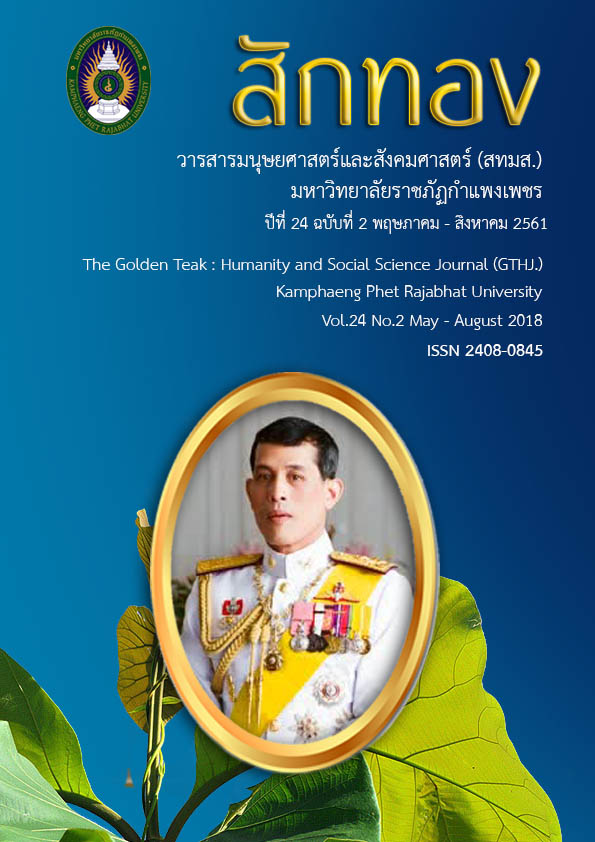The Operation for Crime prevention and Drug use by Public participation in Community Policing Box (KOBAN) Model
Main Article Content
Abstract
ABSTRACT
The objective of this research was to study a model, community context and an appropriate approach in crime prevention and drugs use. The researcher used a qualitative research method. The findings revealed three significant results. Firstly, the KOBAN security box in the Koh Thawee Community, adapted from the Japanese KOBAN, whose operations include: monitoring and maintaining public order in the community, receiving notification of illegal activities, investigating the complaint and suspending dangerous situations, all assisted the organization in finding ways to solve community problems and conduct community activities. Secondly, many problems existed, such as a lack of budgeting, less voluntary community police, dysfunctional community police, carrying firearms, bribery of business compensation, and the inconsistency or lack of meetings. Lastly, the third finding suggested the following approaches for improvement: increased budgeting, increasing the number of voluntary community police, providing improved training of voluntary community police to increase their knowledge and understanding of their own roles, increasing the frequency of regular community meetings, restriction the carrying of firearms, and no paying compensation for voluntary community policeman.
Article Details
บทความที่ได้รับการตีพิมพ์เป็นลิขสิทธิ์ของวารสาร สักทอง : วารสารมนุษยศาสตร์และสังคมศาสตร์ สถาบันวิจัยและพัฒนา มหาวิทยาลับราชภัฏกำแพงเพชร
ข้อคิดเห็นใดๆ ที่ปรากฎในวารสารเป็นวรรณกรรมของผู้เขียนโดยเฉพาะ ซึ่งมหาวิทยาลัยราชภัฏกำแพงเพชรและบรรณาธิการไม่จำเป็นต้องเห็นด้วย
References
Bhakdinarinath, S. (2013). Modern policing: community policing in CSD. Nonthaburi : Green Apple Graphic Printing.
Boonsit, A. (2007). People and community participations in justice system Cited in Teaching Package of Criminal Justice Administration. Book 2 Unit 13 Nonthaburi, Thailand: Sukhothai Thammathirat Open University.
Chanpleng, S. (2011). Guidelines on operational development of sub-district police officers volunteers of Mueang Suphanburi police station. Master’s thesis, Thammasat University.
Chayapan, P. (2012). Before being the policeman serving the people. Bangkok : Silpa Siam Printing.
Chuntron, P. (2015). Practice of the prevention and suppression of crime in the
responsible area of Bangpongpang police station. Master’s Independent Study, Rangsit University, Pathum Thani.
Creighton, J. L. (2005). The public participation handbook: making better decisions
through citizen involvement. San Francisco : Jossey Bass.
Faiparn, W. (2013). Community leaders’ participation in crime prevention In the Phon Sawan district area, Nakhon Phanom province. Master’s thesis, Sakon Nakhon Rajabhat University, Sakon Nakhon.
Funbanrai, N. (2016). The role of the community police volunteers in people’s the safety and property under Phitsanulok police station. Master’s Independent Study, Pibulsongkram Rajabhat University, Phitsanulok.
High crimes, drought and economic problems. (2015, December 10). Cited in Thaipost. [Online]. Available : http://www. thaipost.net/?q= High crimes, drought and economic problems. [2016, February 22].
Kaewporm, U. (2013). Citizen participation in crime prevention utilizing community policing strategy: case study of Mahanak Mosque community, Pomprabsattrupai district, Bangkok metropolitan. Master’s thesis, Chulalongkorn University, Bangkok, Thailand.
Kokpol, O. (2009). Partnership and handbook of people participation for local administrator. Bangkok : Charansanitwong Printing.
Kongnil, W. (2015). Police volunteer community involvement to sole the drug epidemic Thanyaburi police station Pathum Thani. Master’s Independent study, Thammasat University.
Lapchit, S. (2007). Factors affacting people’s decision to participation in Tambon administration organizations in Warinchamrab district, Ubon Ratchathani province. Master’s thesis, Chulalongkorn University.
National Statistical, Office, Government Strategic Information Center. (2013). “Drug addict” returning the good to society. [Online]. Available : http://www.dmh.go.th. [2015, November 10].
Pidgratog, N. (2013). The understanding in role and function of volunteer community police on community housing Din Daeng 2. Master’s Independent Study, Thongsook College.
Prachantawanich, A. (2007). Causal relationships of work environment factors and personal factors related to personal participation in Thammasat university’s educational quality assurance. Master’s thesis, Srinakharinwirot University.
Pratumthong, A. (2011). The development of community police volunteers and the performances of crime prevention in the area of Prachachuen metropolitan police station. Master’s thesis, Chandrakasem Rajabhat University.
Royal Irrigation, Department, Bureau of Public Participatory Promotion. (2009). People participation’s handbook royal Irrigation department. Bangkok : Author.
Saranapiboon, P. (2007). People’s opinion regarding to a community police volunteer.
Master’s Independent Study, Kasetsart University.
Untan, N. (2012). The participation of community police volunteers in anti-crime crackdown: a case study of Muang Chiang Mai police station. Master’s Independent Study, Maejo University, Chiang Mai.
Wattanasin, K. (2013, January 26). Koban is the heart of community policing system in Japan. [Online]. Available: http://gwattanasin.blogspot.com/2013/01/koban.html.
[2017, March 20].
Wongsaroj, T. (2014). The development of a community relations action network model for crime prevention. Doctoral Thesis, Silpakorn University.
Wuncha, Ch. (2017). A model of improving job performance efficiency In crime prevention of community police officers (Koban) of provincial police region 4. Doctoral Thesis, Rajabhat Maha Sarakham University, Maha Sarakham.


